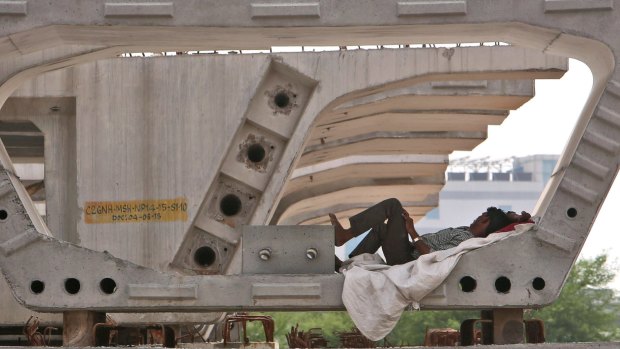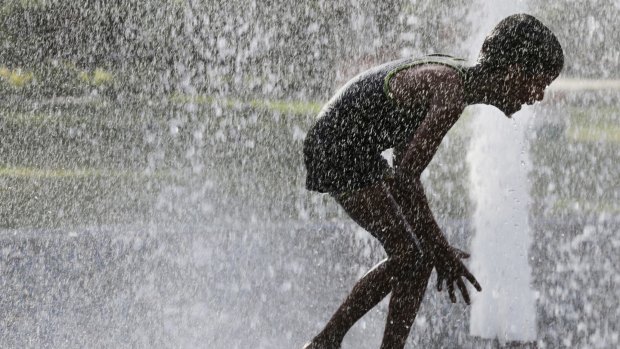This was published 7 years ago
'Like heatwaves were coming out of a clay over': temperature sets record in India
By Nida Najar and Hari Kumar
New Delhi: People weren't frying eggs on the sidewalks in Phalodi during India's hottest day ever – it was so hot that many did not venture out at all.
Heat is a familiar part of life in Phalodi, in the deserts of Rajasthan, so residents were following a familiar drill even before temperatures soared to 123.8 degrees Fahrenheit (51 degrees Celsius) on Thursday: When the heat comes, stay indoors, chug buttermilk and, if you must go out, cover your head and pray for shade. It is a drill that may prove ever more necessary if temperatures continue to rise.

An Indian labourer sleeps under a concrete sections of a flyover bridge in Hyderabad.Credit: Mahesh Kumar A.
Dr Bhani Ram Paliwal, the principal medical officer at a government hospital in Phalodi, could not remember a day like Thursday in 15 years of working there. Roughly 500 patients, almost double the average number, visited his outpatient department, many with complaints of diarrhoea and fever.
"It was like heatwaves were coming out of a clay oven," he said.

An Indian child bathes under a public fountain on a hot afternoon in Lucknow.Credit: AP
Scientists say that if greenhouse gas emissions continue at a high pace, average global temperatures could rise by more than 6 degrees Fahrenheit by the end of the century.
"Climate change is obviously going to be playing a role," said Andrew Robertson, a senior research scientist at the International Research Institute for Climate and Society at Columbia University.
May is typically the hottest month in much of India, Dr Robertson said, with lots of sun and stagnating high-pressure air leading to broiling temperatures.
The Indian Meteorological Department has predicted a severe heatwave for parts of western India over the next two days. Extreme heat was also forecast across central and northern India into next week, though officials say another record high is unlikely.
The heat is amplified by an accompanying drought across much of the country. As farmers await the rains of this season's monsoon, they continue to struggle with the effects of inadequate rainfall from the last monsoon: negligible crop yields, scarce drinking water and emaciated cattle.
"My buffalo is giving only one-third of the normal milk," said Dinesh Bishnoi, a farmer in the village of Sajananiyo ki Dhani near Phalodi. His grandfather, who is 93, "has never seen this kind of heat in his life", he said.
This year, India is facing "a double whammy: more heat and less water", said Dileep Mavalankar, the director of the Indian Institute of Public Health in Gandhinagar, Gujarat, who helped develop the city of Ahmedabad's plan to cope with heatwaves after a deadly one in 2010.
"The main protection against heat is water," he said. "If you don't have adequate water or water gets contaminated, you might die because of diarrhoea and dehydration in the summer."
Last year more than 2400 people died from heat-related illness in India, according to India's National Disaster Management Authority. Many of those who died were labourers and farmhands who work outside, even in peak temperatures, officials said.
India's former record high was 60 years ago, when temperatures reached 123 degrees Fahrenheit in Alwar, also a city in Rajasthan.
The heat makes going outside virtually unthinkable and, experts say, staying indoors is a critical safety measure.
"If you go outside you can't survive in this heatwave," Paliwal said.
The New York Times